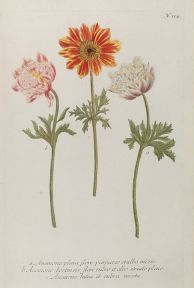Ancient Anemone
By Audrey Stallsmith

Coy anemone that ne'er uncloses
Her lips until they're blown on by the wind.
(Unattributed quote from A Modern Herbal by Mrs. M. Grieve)
Anemones, like auriculas, seem to have been much more popular hundreds of years ago than they are today. Robert Furber's 1730 catalog/calendar, Twelve Months of Flowers, shows some fancy cultivars that would make any modern gardener's eyes pop. (Of course, like all nurserymen, he may have been prone to idealizing the size and/or splendor of his wares!)
In the drawings, those 1730 anemones seem to have large crested centers, with the crest frequently a different color than the outer petals. Although there are many double anemones available now--most of them anemone coronaria (poppy anemone) types--I don't recall seeing any modern crested versions of the flower.
Gerard wrote, in 1597, that "the stock or kindred of the anemones or Wind-floures, especially in their varieties of colours, are without number. . .My selfe have in my garden twelve different sorts. . .every new yeare bringing with it new and strange kindes." He called the double-flowered type "Anemone of Chalcedon."
The plant's name derives from Anemos, the Greek god of wind. He supposedly sent anemone flowers to announce his spring arrival. And, according to popular belief, they would only bloom for him. Gerard wrote that the "floure doth never open it selfe but when the wind doth blow."
Another myth contends that anemones sprang from the tears Venus shed over Adonis' death. "Where streams his blood, there, blushing, springs a rose./ And where a tear has dropped, a windflower grows."
Anemone coronaria is widely believed to be the flower Christ indicated when he said, "Consider the lilies of the field how they grow; they toil not, neither do they spin. And yet I say unto you, that even Solomon in all his glory was not arrayed like one of these." (Matthew 6:28b-29)
Strangely enough, an anemone's petals are not actually petals at all, but an attractive calyx of 6 to 8 sepals that close at night or during rain. Fairies were believed to shelter inside those ethereal "tents."
Since most anemones have finely-cut foliage, the plant has never had a robust look. Poet Matthew Arnold described one variety as "the frail-leaf'd, white anemone." Due either to the flower's frequently wan color, frail appearance, or the blush on its sepal backs--similar to the flush of fever--ancient Egyptians associated the anemone with sickness.
The Chinese went a step farther, calling it the "Flower of Death." Romans, on the other hand, optimistically wore the delicate bloom as an amulet, in hopes that it would help prevent real fever. Although herbalists have made sporadic attempts to find therapeutic uses for the plant, most frequently as a cough remedy, its acrid juice can be toxic. And it doesn't really have enough medicinal value to make up for its bad taste!
Among the anemone's meanings in the Language of Flowers are "abandonment," "expectation," "refusal," or "sickness." We've already seen where "sickness" comes in and can deduce that "expectation" probably derives from the legend of Anemos, "refusal" from the bloom's occasional closing up, and "abandonment" from Venus' bereavement.
Some of the better known types of anemones are anemone hepatica, anemone patens, and anemone japonica. Hepatica derived from the Greek hepar or "liver," although the plant's leaves are actually more kidney-shaped. It is also known as liverwort in the U.S., not to mention liver leaf, kidneywort, and liver weed. The wild form is stemless and only about 6 inches tall with blue to white flowers.
Anemone patens is more often called anemone pulsatilla or pulsatilla vulgaris these days. Its common names are pasque flower and meadow anemone, because it blooms near Easter in sunnier areas than most of its kin. Covered with silky hairs, pulsatilla also has an acrid juice that can blister the skin and inflame the eyes. Its name derives from pulsc or "I beat," in reference to how its seedpods are flailed by the wind. The wild pasque flower's purple sepals were once used to dye Easter eggs green. Gerard reports that pulsatilla sometimes blooms again in September.
The fall-blooming anemone hupehensis, AKA anemone japonica,was brought back from the Orient by colorful Scottish botanist Robert Fortune in 1845. The adventurous Fortune single-handedly repelled a couple different pirate attacks on the Chinese junk in which he was a passenger. While firing on the pirates with a double-barreled "fowling piece," he also had to hold a pistol on the helmsmen of his own boat--to keep them from retreating below-deck with the rest of the passengers and crew.
The anemone too has proved much tougher than people expected! Although not as popular in our day as it seems to have been in Gerard's, it continues to hang in there.
And, from those 1730 pictures I've been mooning over, I suspect that a lot more could be done with this flower than has been attempted in recent years. The first nurseryman to give us some anemones like the ones in the old paintings could make a second Fortune!
Anemones image is from Phytanthoza Iconographia, courtesy of the Missouri Botanical Garden.








